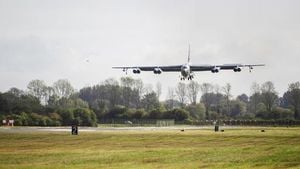On January 29, 2025, tragedy struck as an American Airlines regional jet collided with a Black Hawk military helicopter over the Potomac River, near Washington, D.C. The incident, which occurred shortly before 9 p.m. EST, resulted in the loss of 67 lives, marking one of the deadliest air disasters in recent U.S. history.
The plane, identified as Flight 5342, was carrying 60 passengers and four crew members who had just departed from Wichita, Kansas. It was on its final approach to Ronald Reagan Washington National Airport when it and the helicopter reportedly collided mid-air. All individuals aboard both aircraft are feared dead, with rescue operations launched immediately following the accident.
Officials, including newly appointed Secretary of Transportation Sean Duffy, emphasized the preventability of the crash during a news conference. "The skies over Ronald Reagan Washington National Airport were clear, and the final approach was standard," Duffy stated, adding, "This collision was absolutely preventable." President Donald Trump also expressed his sorrow, labeling the crash as a "tragedy of terrible proportions" and raised concerns about air traffic control communication.
A recording obtained by LiveATC.net indicated communication between air traffic control and the Black Hawk helicopter, known as PAT 25, just moments before the crash. The controller had confirmed knowledge of the passenger plane's approach and instructed the helicopter crew to maintain visual separation. "PAT 25, do you have CRJ (the American Airlines aircraft) in sight?" was heard on the recording. Despite these warnings, the helicopter continued on its path.
According to reports, the American Airlines jet was approximately 400 feet above the ground, traveling at 140 miles per hour when it experienced a rapid loss of altitude. Video footage showed the aircraft merging together before both plummeted downwards. Fire Chief John Donnelly of the Washington D.C. Fire Department confirmed on Thursday morning, "At this point, we don't believe there are any survivors from this accident." The wreckage was located near the Potomac River, with divers dispatched to search for bodies.
The crash has sent shockwaves through the figure skating community, as it was later revealed several skaters, coaches, and family members were aboard the flight, returning from the U.S. Figure Skatings Championships. "We are devastated by this unspeakable tragedy and hold the victims’ families closely in our hearts," U.S. Figure Skatings stated.
Among the victims were former world champion figure skaters Evgenia Shishkova and Vadim Naumov, both respected coaches who had dedicated their post-competitive careers to training young athletes. The emotional toll of their absence is deeply felt within the skating community.
Senator Jerry Moran from Kansas expressed his personal connection to the tragedy, having flown the exact route numerous times. "This is certainly true for many families affected by this loss," he remarked, highlighting the shock felt within the Wichita community.
The helicopter, on the other hand, was engaged in annual proficiency training and was reportedly manned by experienced military personnel. Duffy indicated investigations are being spearheaded by the National Transportation Safety Board (NTSB), with additional backing from military and Federal Aviation Administration officials. Duffy also clarified communications errors might have contributed to the accident, noting air traffic controllers were aware of both aircrafts’ positions prior to the crash.
Virginia's governor, Glenn Youngkin, expressed condolences as rescue efforts continued, with rescue teams from D.C. and across Northern Virginia mobilized quickly to the scene to support search operations. Efforts have faced challenges, especially considering the conditions of the river and the weather, which included gusty winds and cold water temperatures.
This tragic event is not just about numbers; it resonates with individuals, families, and communities. The pain of losing loved ones who were returning from what should have been a joyous event highlights the fragility of life and the importance of rigorous safety measures and operational protocols.
That night, Reagan National Airport's operations were severely disrupted, with multiple flights diverted due to the crash. The FAA announced the airport would remain closed until the following day as investigations began.
During the aftermath of the tragic collision, grieving families were faced with the immense challenge of coping with their loss. Many expressed disbelief and sorrow as reports surfaced about the nature of the crash. One community leader shared, "When one person dies, it’s a tragedy. But when many people die, it’s just unbearable." This sentiment encapsulates the shared grief felt across the nation and among those connected to the victims.
The NTSB will focus on the communication protocols between the air traffic control and the involved aircrafts, alongside assessing the human factors leading to the collision. Survivors’ families remain engaged with authorities hoping for timely answers as to how such a tragedy could occur in the heavily regulated D.C. airspace.
Following the disaster, there is hope for reform, as policymakers and aviation boards deliberate on enhancing monitoring and communication methods to prevent future occurrences. All indications suggest this air disaster will prompt significant discussions on aviation safety standards and practices.
Each life lost during the tragic accident represented hopes, dreams, and communities awaiting their safe return home. The challenge now lies not only with remembering the lost but ensuring such tragedies do not happen again.



